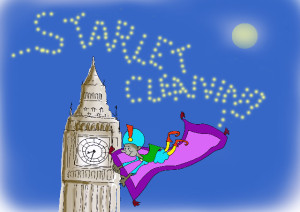In the Disney version of Aladdin, the hero woos the Princess Jasmine by taking her on a magic carpet ride. Defying gravity, wind-resistance and the laws of aerodynamics they swoop past the Pyramids of Egypt and the Parthenon of Athens, all in the time it takes to sing a schmaltzy love duet.
Although Disney had taken liberties with both geography and the original story, it made for some spectacular animation sequences as  the carpet flew through the clouds and skimmed across the waters.
the carpet flew through the clouds and skimmed across the waters.
The magic carpet of fable is associated with sumptuous courts from an Arabian golden age, with genies in lamps, beautiful princesses and wicked grand viziers. It is the fantasy mode of escape that can be relied upon to rescue a good Middle Eastern fairy tale. It lets heroes and heroines escape from their palace prisons and see the world.
This genre of fairytale arrived in Europe three hundred years ago when a collection of stories was published as ‘The 1001 Arabian nights’. Over time other folktales were added, including Aladdin and Sinbad the Sailor. In Britain some of them evolved into Pantomime plots and later, in Hollywood, into children’s films.
The first magic carpets in literature did not fly so much as teleport their users to far distant places. It was a devise more Startrek than Ali Baba. Sit on the magic carpet bought by Prince Husain from an Indian merchant, as related in one of the original 1001 tales, and all you had to do was wish to be in another place and hey presto you were there! The prince had been on a quest to find the world’s most amazing object. He was in competition with his two brothers for the hand of a beautiful princess they all three loved. So a magic carpet was a winner.
One fabled carpet that was more transporter than teleporter was that of King Solomon. In one ancient Islamic version of the story, his carpet is not fabric, but made of wood. He could place his possessions on top, including horses, camels and troops and command the wind to carry everything to wherever he wished to travel. Solomon himself travelled underneath, a bit like sitting in the cabin of an airship, so as to be protected from the heat of the sun.
In another version of the fable he flew on a silken carpet sixty miles long and sixty miles wide. He travelled so quickly that he ‘breakfasted in Damascus dined in the land of the Medes’. To travel almost 600 miles in ten hours at a time when no one could travel faster than a galloping horse would have seemed truly astonishing.
The carpet was said to have been shielded from the sun by flocks of birds. Unfortunately, like modern air travel, flying with Air Solomon had its dangers. Once when the king became too proud of his amazing flying carpet, the carpet shuddered and thousands of his subjects fell to the ground.
The King Solomon stories have their roots in the Islamic scriptures for, although there is no specific mention in The Qur’an of the all-wise king having a magic carpet, there is a verse in which Solomon is described as being able to command the wind to take him to where he wishes to go.
Magic carpets turn up in traditional stories from other parts of the world. For instance Ivan the Fool in Russian Folklore is given a flying carpet by a mysterious supernatural figure called Baba Yaga. The 19th century Russian artist Viktor Vasnetsov illustrated the story in a very Arabesque style. Whether the story had grown up independently or had travelled from Arabia and been adapted for local circumstances is unclear.
The American writer Mark Twain also borrowed the flying carpet idea for a sequence in his story ‘Captain Stormfield’s Visit to Heaven’.
‘Go outside and stand on that red wishing-carpet, he is told. Shut your eyes, hold your breath, and wish yourself there …
‘I hopped onto the carpet and held my breath and shut my eyes and wished I was in the booking office of my own section. The very next instant a voice I knew sung out in a business kind of a way.’
The Father Christmas story also contains a version of the flying carpet legend. In his case he flies magically through the air on a sleigh. The origin of this story is said to lie in Sami culture of northern Europe and is based on the stories told by the shaman who went on fabulous journeys in their minds after eating hallucinogenic mushrooms.
Few people today go on such exotic trips, but most of us have had strange dreams in which we have flown through the air at will. Perhaps this is the common experience that enables magic carpets stories to resonate in so many cultures.
And as everyone wakes from their flying fantasies, so in the stories of flying carpets, no mere mortal is allowed to keep a magic carpet forever. At best carpets are on long-term loan from the realms of magic. Normally, they were lent on two conditions: one, that they are used only for good and two, that they were returned clean and undamaged. Should a carpet be charred from an encounter with a ferocious dragon, it would be permissible to ask a genie to restore it.
But for carpets soiled by careless use, smeared with jam from a picnic or covered in coffee or red wine stains after a particularly bumpy ride – then they had to be cleaned the normal way. It would have been a job for Starlet’s carpet cleaners had they been around in those far off never-never days.
Fortunately, today we can be summoned up to clean ordinary carpets as if by magic! Get in touch for a free carpet cleaning quote today!
No Comment